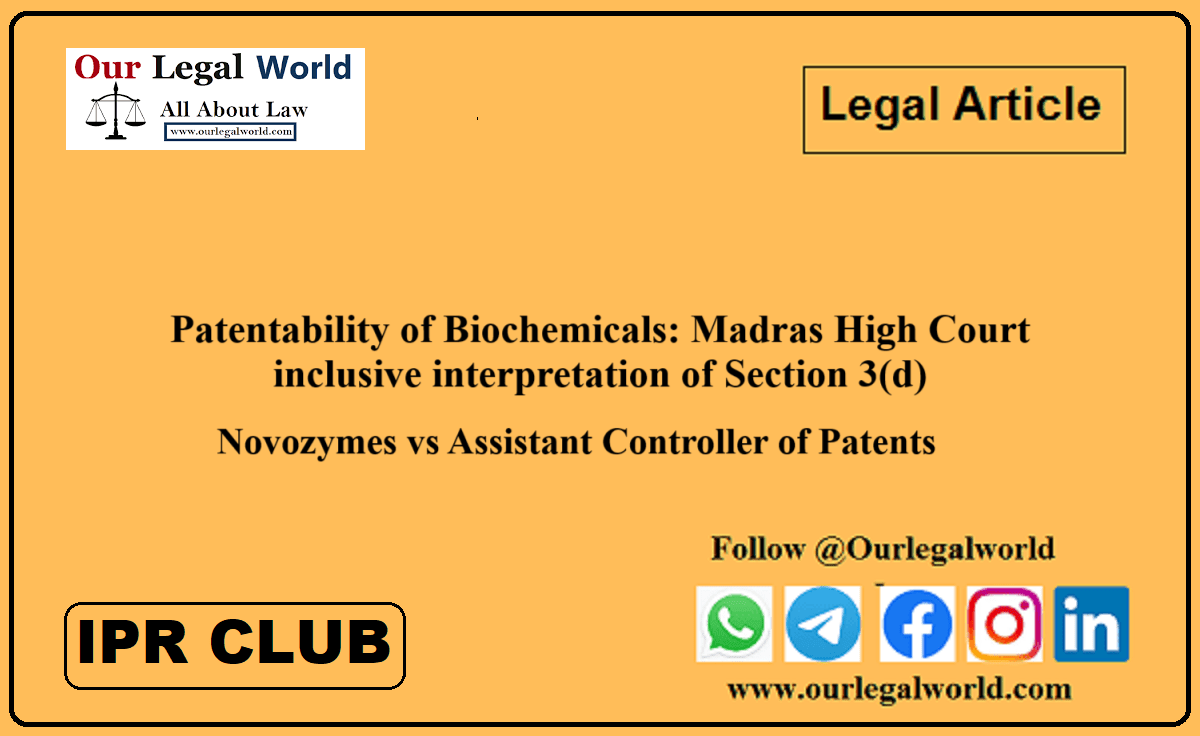Patentability of Biochemicals : Madras High Court’s inclusive interpretation of Section 3(d) rin the Novozymes case.
Manaswini, 2nd year {National Law University, Delhi}
INTRODUCTION
The Madras High Court’s decision in Novozymes vs Assistant Controller of Patents[1]is not only instrumental in understanding the implications of section 3(d) in the biochemical realm, but also for highlighting a distinct approach to interpreting “enhanced efficacy”. The issue at hand relates to the applicability of the section as mentioned earlier to non-pharmaceutical substances or substances not used for medicinal or therapeutic or any other treatment of human beings or animals.
BACKGROUND FACTS
The appellant was seeking to patent “phytase variants with Improved thermostability”, a catalyst facilitating digestion used in animal feed. The appeal was filed to contend the rejection of the patent application by the Indian Patent Office (IPO) under section 3(d) for being a “new form” of a known enzyme and for not showing enhanced efficacy.[2] In challenging the decision, the appellant raised three key contentions wherein they challenged the applicability of section 3(d) to enzymes, which do not qualify as a drug; relied on the principle of ejusdem generis to exclude enzymes from the explanation to section 3(d); and averred that enhanced thermostability did indeed result in enhanced efficacy of the product. There was further exposition on the applicability of section 3(e) on composition claims 8 to 11, as it was held by IPO that the composition was obtained by the mere admixture of ingredients. [3]
UNDERSTANDING & EXPANDING THE LIMITS OF SECTION 3(D)
Section 3(d) is a sui generis provision, intended to erect an additional barrier to the patentability of pharmaceutical substances for prevention of evergreening. It reads as follows:
“ 3. What are not inventions. – ….
(d) the mere discovery of a new form of a known substance which does not result in the enhancement of the known efficacy of that substance or the mere discovery of any new property or new use for a known substance or of the mere use of a known process, machine or apparatus unless such known process results in a new product or employs at least one new reactant.
Explanation: For the purposes of this clause, salts, esters, ethers, polymorphs, metabolites, pure form, particle size, isomers, mixtures of isomers, complexes, combinations and other derivatives of known substance shall be considered to be the same substance, unless they differ significantly in properties with regard to efficacy”
Novartis had established that the explanation appended to the provision was only applicable to medicines and drugs.[4] However, Justice Senthilkumar Ramamoorthy begins by taking a very textualist approach to interpreting the scope of the relevant clause. He observed that the use of the disjunctive “or” in the language signifies that the conditions need not be met concurrently and subsequently dissected the clause in three limbs as follows –
- The discovery of a new form of the known substance
- The discovery of any new property or new use of a known substance
- The mere use of a known process or apparatus
This bifurcation reveals that both the first and second limbs pertain to “known substances”.
Defining “Known Substances”
The fundamental question was whether biochemical substances could be included in the ambit of “known substance”, or is it restricted to solely pharmaceutical chemicals. The appellant relying on Novartis Division Bench Judgment and Novartis Supreme Court Judgment argued that both the actual provision and the explanation cover exclusively the field of pharmacology.[5] Referring to both these judgments, the court observed that the explanation to s.3(d) is limited to pharmaceutical substances and the provision itself does not preclude biochemicals from its scope. Furthermore, while the Parliament may have intended to limit the scope of the provision to drugs, medicines or agrochemicals,[6] there is no indication that “known substances” are necessarily defined as pharmaceuticals only.
Also Read: PIDILITE INDUSTRIES V SANJAY JAIN: Case Study
On the application of ejusdem generis, the appellant argued that the enumerated derivatives in the explanation of the clause are derivatives of chemicals that do not originate from a living organism. The court agreeing with this contention held that the derivatives mentioned in the explanation fall within the genus “derivatives of chemical substances” and therefore the explanation is inapplicable to the claimed invention. However, much remains to be said about the fact that pure form and particle size are not only associated with synthesized chemicals but also any substance that had been extracted by a biological process succeeded by purification and isolation. Similarly, isomerism and isomers have been associated with the biological field. [7]
The court further clarified that if the claimed invention (phytase variant) does not fall within the scope of the explanation to s.3(d), it can still be considered a ’new form of a known substance’ even if it does not satisfy the requirement set out in the explanation. Essentially, the invention may still be scrutinized under Section 3(d), but the specific criteria from the Explanation do not apply to this type of claim. However, the appellant would not be entitled to a patent unless the discovery passes the test of “result in the enhancement of known efficacy of the substance” under the main rule.
Efficacy in the Context of Biochemical Substances
Logically what follows from the above discussion is defining what constitutes efficacy in the context of biochemical substances. The question was somewhat ambivalently addressed in Novartis where the court established that the test for efficacy would vary according to the desired or intended result that the product is expected to produce. Therefore, efficacy would be determined by the function, utility or purpose of the product under consideration. Such a broad definition allows to bring in other substances within the scope of the clause.
The IPO contended that the invention could only meet the requirement of enhanced efficacy if the improvement was specifically related to how effectively the enzyme functions, similar to the test of “therapeutic efficiency”. However, the court rejected this contention and noted that the increased thermostability of the phytase variants prevents denaturation and facilitates production, storage and sale in pellet form. Consequently, this improves the efficacy of the enzyme in promoting digestion especially when used in animal feed.
As to what the empirical standard for this efficacy is, the court was of the view that the guidelines of the Patent Office have not set a numerical value, the only measure is that the enhancement must be “reasonable” to the satisfaction of the Controller of Patents.
CLAIMS UNDER SECTION 3(E)
Section 3(e) restricts the grant of a patent for compositions that result from a mere admixture of components unless the combination possesses properties that are not just the aggregation of the individual properties of the components. Claims 8 – 11 in the present case, involved compositions containing various enzymes, including phytase, fat-soluble and water-soluble vitamins, and trace minerals, are assessed under this provision. The respondent contended that section 3(e) applies because the compositions in these claims merely aggregate the individual properties of the ingredients without exhibiting any synergistic effect, which would be necessary to qualify for a patent.
The court stressed the absence of the term “known” in s.3(e) and highlighted that this distinguished it from other clauses such as Sections 3(d), 3(f), and 3(p), which use the qualifier “known” to restrict their application to existing substances or devices. Thus, Section 3(e) is interpreted as applying to any composition claim, regardless of whether the components are novel or known.
Ultimately, the court upheld the rejection of the composition claims under Section 3(e) due to the lack of evidence showing that the combination resulted in synergistic properties beyond the mere aggregation of the individual properties of its components.
CONCLUSION
The decision highlights several key issues regarding the inclusion of biochemicals within the scope of section 3(d). The decision also raises the need for clearer guidelines on evaluating “enhanced efficacy” for biochemical substances, especially when physicochemical properties like thermal stability are involved. It further emphasizes the importance of defining “New Biochemical Substance” for better patentability determination, signaling a need for future case law and practice framework refinements.
[1] Novozymes vs Assistant Controller Of Patents, Madras High Court, 19th March 2024, (T)CMA(PT) No.92 of 2023
[2] Indian Patents Act 1970, Sec 3(d)
[3] Novozymes (n 1)
[4] Novartis AG v. Union Of India (Novartis DB), Manu/TN/1263/2007; Novartis AG v. Union of India (Novartis SC), (2013) 6 SCC
[5] Ibid
[6] Ibid para 94-98
[7] Amit tailor, ‘‘Non’-Pharmaceutical Substance and Efficacy under Sec 3(d)’ (SpicyIP, 19 February 2024) < https://spicyip.com/2024/02/non-pharmaceutical-substance-and-efficacy-under-sec-3d.html>








